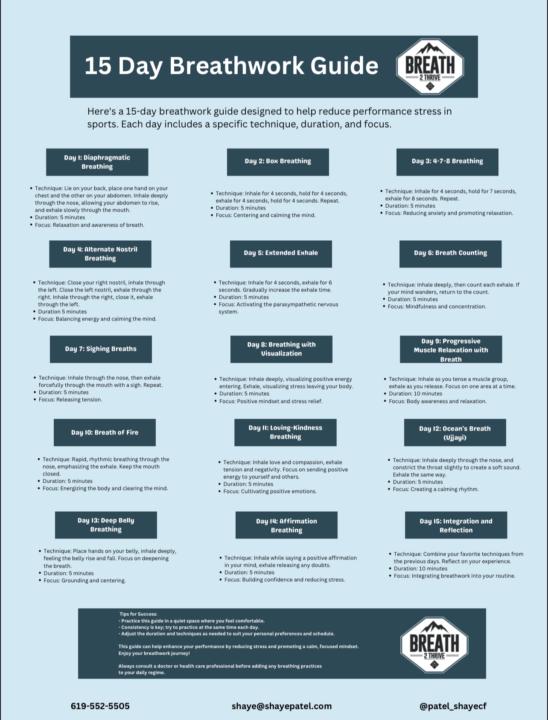
Write something
Pinned
WELCOME TO BREATH 2 THRIVE!
I'm so glad you have chosen to join me on this mental and physical growth journey. Through B2T, I want to help individuals and connect like minded individuals who wish to learn and grow together. I will be sharing my passion for coaching and mentoring through breathwork, mental resiliency, and CO2 tolerance training to assist you in achieving your goals. #coachingislife Feel free to introduce yourself and what you would like to learn more about through our network
Pinned
Open invitation for you friends and family!
If anyone would like to invite their friends, family or peers please feel free to do so using this link. https://www.skool.com/breath2thrive The more the merrier. Starting next week, I will take a poll to see when we can schedule.a virtual group breath work session followed by a Q & A
15 Day Breathwork Guide PDF
Hey Y'all, I wanted to share this PDF I put together. Please let me know if you have any questions.

UNDERSTANDING STRESS: THE BALANCE BETWEEN HOMEOSTASIS AND ALLOSTASIS
Stress isn’t always the enemy. In fact, it’s essential for growth, performance, and survival. But the way your body handles stress determines whether it builds you up—or breaks you down. Let’s look at two key concepts behind this: homeostasis and allostasis. HOMEOSTASIS: YOUR BODY’S BASELINE Homeostasis is your body’s “default mode”—a steady internal state where systems like heart rate, temperature, and pH are kept within narrow, optimal ranges. When you’re calm and recovered, your body prioritizes rest, digestion, and repair. This is your physiological ground zero. ALLOSTASIS: ADAPTATION IN ACTION Allostasis is what kicks in when you’re under pressure. It’s how your body achieves stability through change—activating stress hormones like cortisol and adrenaline, increasing your heart rate, and sharpening focus so you can perform under pressure. Stressful situations—whether it’s a workout, a big presentation, or emotional conflict—rely on allostasis to help you adapt in real time. THE DOWNSIDE: ALLOSTATIC LOAD When stress is short-lived, allostasis helps you grow. But if it becomes chronic, or recovery is poor, your body never fully returns to baseline. Over time, this builds allostatic load—the wear and tear on your brain and body. Symptoms? Fatigue, poor sleep, inflammation, low resilience, and eventually burnout. THE SOLUTION: TRAIN YOUR STRESS RESPONSE Resilience isn’t about avoiding stress—it’s about recovering well. Tools like breathwork, sleep hygiene, contrast therapy, and mindfulness train your nervous system to return to homeostasis faster. The goal? Stay adaptable. Stress to grow, then return to calm. TAKEAWAY Stress isn’t bad. Staying stressed is. Learn to shift between stress (allostasis) and recovery (homeostasis), and you’ll unlock a new level of performance and well-being. — Want to learn how to build your stress resilience and train your nervous system like a high performer? Please reach out!
4
0
Power of Nasal Breathing on Athletic Performance
https://cdn5.dcbstatic.com/files/x/p/xptlife_docebosaas_com/1745517600/oOYpJw1YvVhQtq0ZvPobOA/item/a43a77d988822130546ed43c7409ba88c13834fa.pdf This research presentation titled "The Effects of Nasal Breathing on Exercise Tolerance" by Thomas et al. (2009), presented at the Chartered Society of Physiotherapy Annual Congress. The study investigates the impact of nasal-only breathing on exercise performance in healthy university students. Key Findings: - Nasal Breathing Benefits: Nasal breathing filters, warms, and moistens the air, providing cleaner and more optimal conditions for the lungs compared to mouth breathing. It also adds nitric oxide to inspired air, which acts as a bronchodilator and vasodilator, enhancing respiratory efficiency. - Exercise Performance: The study aimed to determine whether individuals could maintain nasal breathing during incremental exercise and how it affects exercise tolerance. While the specific results are not detailed in the provided excerpt, the research suggests that training individuals to sustain nasal breathing during physical activity could improve exercise performance and respiratory health. - Implications for Physiotherapy: The findings highlight the importance of incorporating nasal breathing techniques into physiotherapy practices, especially for patients with respiratory conditions. It suggests that physiotherapists should consider training individuals to prolong nasal breathing during exercise to enhance respiratory function and overall health. This research underscores the significance of nasal breathing in maintaining optimal respiratory health and its potential benefits in improving exercise tolerance. Let me know what you think.
5
0
1-30 of 73

skool.com/breath2thrive
Welcome to the Breath 2 Thrive.
A community for individuals to improve their personal, professional, and athletic performance through breath.
Powered by
